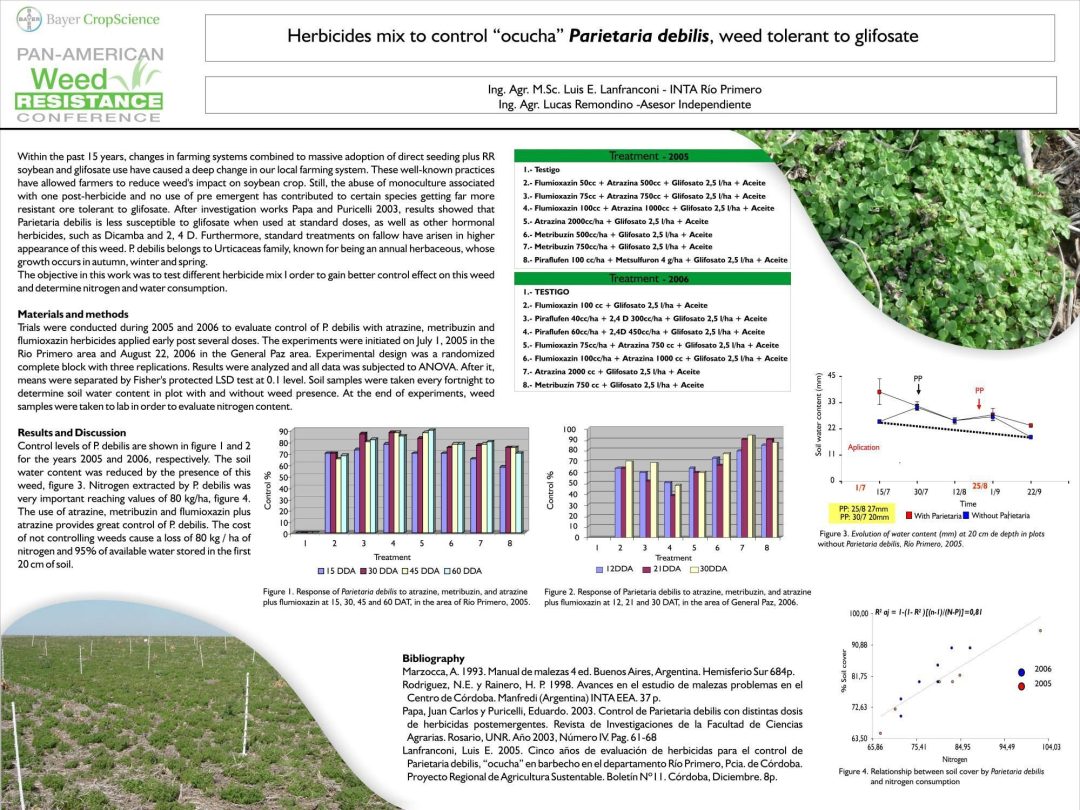Ing. Agr. M.Sc. Luis E. Lanfranconi – INTA Rfo Primero – ing. Agr.Lucas Remondino – Asesor Independiente
Within the past I 5 years, changes in farming systems combined to massive adoption of direct seeding plus RR soybean and glifosate use have caused adeep change in our local farming system. These well-known practices have allowed farmers to reduce weed’s impact on soybean crop.Still, the abuse of monoculture associated with one post-herbicide and no use of pre emergent has contributed to certain species getting far more resistant ore tolerant to glifosate. After investigation works Papa and Puricelli 2003, results showed that Parietaria debilis is less susceptible to glifosate when used at standard doses, as well as other hormonal herbicides, such as Dicamba and 2, 4 D. Furthermore, standard treatments on fallow have arisen in higher appearance of this weed. P. debilis belongs to Urticaceas family, known for being an annual herbaceous, whose growth occurs in autumn, winter and spring. The objective in this work was to test different herbicide mix I order togain better control effect onthis weed and determine nitrogen and water consumption.
Materials and methods
Trials were conducted during 2005 and 2006 to evaluate control of P. debilis with atrazine, metribuzin and flumioxazin herbicides applied early post several doses. The experiments were initiated on July I, 2005 in the Rio Primera area and August 22, 2006 in the General Paz area. Experimental design was a randomized complete block with three replications. Results were analyzed and all data was subjected to ANOVA. After it, means were separated by Fisher’s protected LSD test at 0.1 level. Soil samples were taken every fortnight to determine soil water content in plot with and without weed presence. At the end of experiments, weed sampleswere taken to lab in orderto evaluate nitrogen content.
Resultsand Discussion
Control levels of P. debilis are shown in figure I and 2 for the years 2005 and 2006, respectively. The soil water content was reduced by the presence of this weed, figure 3. Nitrogen extracted by P. debilis was very important reaching values of 80 kg/ha, figure 4. The use of atrazine, metribuzin and flumioxazin plus atrazine provides great control of P. debilis. The cost of not controlling weeds cause a loss of 80 kg I ha of nitrogen and 95% of available water stored in the first 20cm ofsoil.
Bibliography
Marzocca, A. 1993.Mnual demalezas4 ed. Buenos Aires, Argentina. Hemisferio Sur 684p. Rodriguez, N.E. y Rainero, H. P. 1998.Avances en el estudio de malezas problemas en el Centrode Cordoba. Manfredi (Argentina) INTA EEA.37 p.
Papa, Juan Carlos y Puricelli , Eduardo. 2003.Control de Parietaria debilis con distintas dosis de herbicidas postemergentes . Revista de lnvestigaciones de la Facultad de Ciencias Agrarias. Rosario, UNR. Mo 2003, Numero IV. Pag. 61-68.
Lanfranconi, Luis E. 2005. Cinco aiios de evaluacion de herbicidas para el control de Parietaria debilis, “ocucha” en barbecho en eldepartamento Rio Primero, Pcia. de Cordoba.
Proyecto Regional de Agricultura Sustentable. Boletin N°I I .Cordoba, Diciembre. Sp


